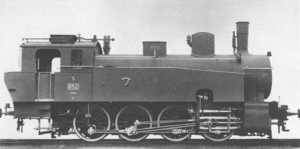Württemberg T 4
| Württemberg T 4 DRG Class 92.1 | |
|---|---|
 | |
| Number(s): | Nr. 851–858 DRG 92 101–92 108 |
| Quantity: | 8 |
| Manufacturer: | Maschinenfabrik Esslingen |
| Year(s) of manufacture: | 1906 and 1909 |
| Retired: | by 1948 |
| Wheel arrangement: | 0-8-0T |
| Axle arrangement: | D n2t |
| Type: | Gt 44.16 |
| Gauge: | 1,435 mm |
| Length over buffers: | 11,000 mm |
| Height: | 4,650 mm |
| Overall wheelbase: | 4,650 mm |
| Empty weight: | 49.80 t |
| Service weight: | 64.50 t |
| Adhesive weight: | 64.50 t |
| Axle load: | 16.10 t |
| Top speed: | 52 km/h |
| Coupled wheel diameter: | 1,380 mm |
| Driving wheel diameter: | 1,380 mm |
| Valve gear: | Walschaerts (Heusinger) |
| No. of cylinders: | 2 |
| Cylinder bore: | 530 mm |
| Piston stroke: | 612 mm |
| Boiler Overpressure: | 14.0 bar |
| No. of heating tubes: | 266 |
| Heating tube length: | 4,000 mm |
| Grate area: | 2.08 m² |
| Radiative heating area: | 9.70 m² |
| Tube heating area: | 133.70 m² |
| Evaporative heating area: | 143.40 m² |
| Water capacity: | 6.00 m³ |
| Fuel: | 1.50 t coal |
| Locomotive brakes: | Screw brake, Counterpressure brake |
The Württemberg T 4 was a class of German, eight-coupled, goods train, tank locomotive operated by the Royal Württemberg State Railways.
When the T 3 locomotives were no longer capable of banking services on the Geislinger Steige, a locomotive was designed that was to develop twice the power. Because no more locomotives were needed for duties on the ramps, only eight were produced, of which five were supplied in 1906 and three in 1909. In their day they were the heaviest eight-coupled locomotives in Germany.
In designing the boiler, special emphasis had been laid on a large steam space and a low-lying firebox crown so that banking could be achieved with refilling with water, which led to a reduction in boiler pressure and a resultant drop in performance.
In order to reduce wear and tear on the tyres and brake shoes during descents, the engines were fitted with Riggenbach counterpressure brakes.
In 1925 the Deutsche Reichsbahn took over all eight locomotives and grouped them into DRG Class 92.1 in their numbering plan. After the Second World War they ended up in the Deutsche Bundesbahn, where they were retired between 1946 and 1948 or sold as industrial locomotives.
See also
External links
- There is a relevant English-language forum at Railways of Germany
| |||||||||||||||||||||||||||||